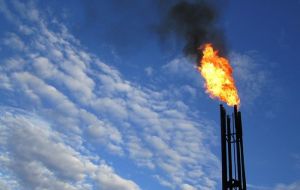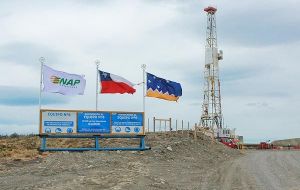MercoPress. South Atlantic News Agency
Magallanes region in south Chile could hold a treasure of unconventional tight gas
 USGS provided a mean estimate of 8.27 trillion cubic feet of gas and 83 million barrels of natural gas liquids.
USGS provided a mean estimate of 8.27 trillion cubic feet of gas and 83 million barrels of natural gas liquids.  ENAP so far has concentrated its efforts and exploration in the Arenal block in Tierra del Fuego, where only last year 52 wells were drilled
ENAP so far has concentrated its efforts and exploration in the Arenal block in Tierra del Fuego, where only last year 52 wells were drilled The U.S. Geological Survey estimates that the Glauconitica zone of Chile's southernmost Magallanes region holds nearly 8.3 trillion cubic feet of technically recoverable, unconventional tight gas, or nearly double Chile's production of that fossil fuel over the past 70 years.
Chilean state-owned energy company ENAP said those reserves would be sufficient for eventually creating a petrochemical pole in the area and even supplying natural gas to the rest of the country.
“The study is important because it was carried out using specific geological information from the basin and took into account the results of 'tight gas' wells currently in production,” ENAP said in a statement.
The USGS provided a mean estimate of 8.27 trillion cubic feet of gas and 83 million barrels of natural gas liquids. By comparison, Chile's total gas production since 1945 amounts to 4.2 trillion cubic feet.
Based on its calculations, there is a 95% chance that the Glauconitica zone holds at least 2.46 trillion cubic feet of gas and 23 million barrels of natural gas liquids and a 5% chance that it holds at least 16.29 trillion cubic feet of gas and 172 million barrels of natural gas liquids.
The USGS said the range of resource estimates “reflects considerable geologic uncertainty, particularly with respect to the geologic boundaries of the Zona Glauconitica AU.”
Therefore, “other unconventional oil and gas accumulations might be present in the Magallanes Basin Province ... but these potential accumulations were not quantitatively assessed at this time.
ENAP so far has concentrated its efforts and exploration in the Arenal block in Tierra del Fuego, where only last year 52 wells were drilled, demanding an investment of 250 million dollars and with ”the best prospects”.
ENAP's investment program for 2014/25 originally had estimated 800 million dollare annually, hoping to make Chile in the short term natural gas self sufficient.
Only a few weeks ago the government of president Michelle Bachelet signed an agreement for the daily export of 5.5 million cubic feet of natural gas to energy hungry neighboring Argentina. The program aslo includes a joint effort from ENAP and YPF to try and develop hydrocarbons sources precisely in the Magallanes region.




Top Comments
Disclaimer & comment rules-

-

-

Read all commentsthe little poison dwarff will be screaming its. mine. its mine
Feb 04th, 2016 - 11:57 am 0What this story did not mention:
Feb 04th, 2016 - 12:42 pm 01. Extraction costs for this potential unconventional source are comparatively high.
2. Chilean sales of natural gas right now are done at a net loss within the Magallanes region, since the sales are heavily subsidised. ENAP operates at a huge deficit due to the subsidies schedule. The annual residential subsidies involve about US$77 million for the region with only about 163,000 people. This means that residents pay only a tiny fraction of the market value of the natural gas and as a result, energy conservation is severely lacking. Since it's cheaper to burn excessive amounts of nearly free gas, there is little interest in energy-efficient construction methods and materials and many houses have no wall or ceiling insulation at all.
3. “...hoping to make Chile in the short term natural gas self sufficient...” would be impractical since the aggregate of production, liquefaction/regasification, transport, existing and predicted subsidies, and other costs would be significantly higher than near-term costs using existing suppliers.
The current extremely high subsidies for residential natural gas in this region are the result of the socialist governments prior to 2011, and the demonstrations that took place that year objecting to reductions in subsidies. The demonstrations resulted in significant economic harm to the region and caused the Chilean military to evacuate foreign tourists who were trapped by the protesters. Unlike the current Macri government in Argentina, the national government in Chile has repeatedly shown itself to be too weak to significantly reduce these natural gas subsidies.
The original USGS report from which the article's material was extracted is here: “Assessment of Unconventional Tight-Gas Resources of the
Magallanes Basin Province, Chile, 2015”
A rather uneven discussion of the 2011 gas-subsidies rebellion is here https://es.wikipedia.org/wiki/Protestas_en_Magallanes_de_2011
Perhaps the USGS should speak to Dilma....she seems to be holding in a lot of unconventional tight gas in her midriff....I doubt it would help Brazilians much but I'm sure it would empty Congress of the opposition if she decided to let it go free in there...
Feb 06th, 2016 - 11:24 pm 0Commenting for this story is now closed.
If you have a Facebook account, become a fan and comment on our Facebook Page!